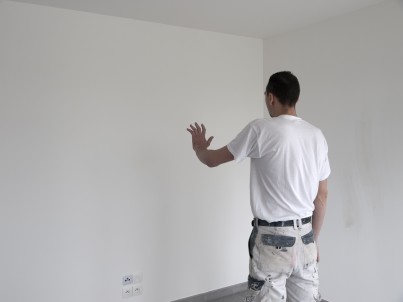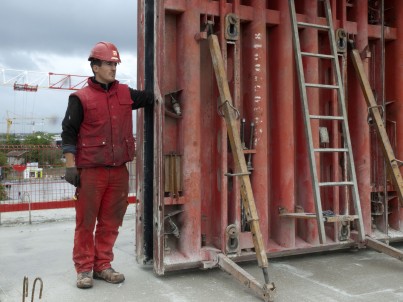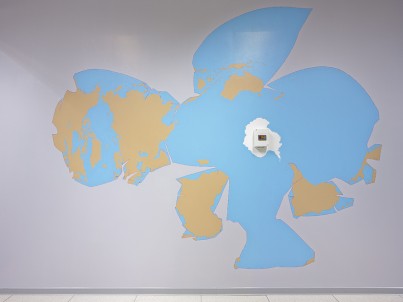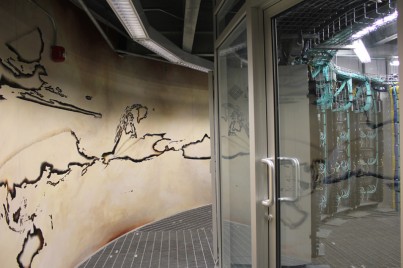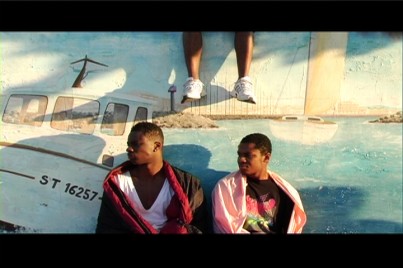THE BBB CENTRE D’ART
plays
ACQUAINTANCE
with
Christian Ruby
Connection and disconnection
Interaction between creation AND mediation in light of contemporary art
The BBB centre d’art is set up in a former industrial electrical coil factory in Toulouse. Its team has been supporting contemporary artists in the field of plastic and visual arts since 1993. Production, works distribution and the conditions of their reception by art professionals and enthusiasts are the everyday life, ambition and long-term work of our trade. Creation AND mediation? This is the free invitation and question raised by Christian Ruby.
Many discussions about contemporary culture still oppose creation and mediation. It is not uncommon to hear each of these notions defined in a tight-knit context. This way of fixating words, of isolating them, has a detrimental effect upon thinking. Above all it fails to acknowledge any links currently conceivable between existing cultural activities.
Our research into a European cultural history of spectators has strongly indicated that we cannot talk about classic, modern or contemporary exhibition works (as opposed to religious works), without referring in equal measure to spectators and artists. Also the spectator is the subject of an art, and by continuously being renewed, is likely to make a work of art of the spectator himself. These dynamics correlating works of art and spectators provide thinking material for this theme: creation and mediation, and above all outline the potential changes.
In a word, offering to determine the relationships between creation and mediation, means first of all understanding that words, like the people and the activities designated by them, cannot exist in full measure as separate worlds, under pain of death. It is necessary to stress the connections – and/or – and, as a consequence, the possible exchanges between them or the shift in their relationships. We must also learn to wield the function of ‘and,’ in such a way that it does not indicate overwhelming totality, but is instead in line with plurality banking on a continuation. This conjunction must involve friction, allowing new energy producing surfaces to prevail on both sides of the relationships between creator and mediator, in mediation intrinsic to creation (act and result), in creation intrinsic to mediation, lastly, in the relationship between creation and mediation.
A Mechanical Separation
Those who know the field of art know that it not only encompasses creators and creations, but at the very least spectators and mediators too: dealers; cultural intermediaries; institutional staff of the French Republic, …
If you are familiar with this field, you will also know that, since the expansion of cultural mediation (1980), relationships between creators and mediators have been strained, like between Jean de la Fontaine’s monkey and cat (in the eponymous fable). More often than not they ignore each other or pitch themselves against each other, sometimes believing that they have been duped. More often than not, those at the top of their field feel indebted to those prominent in mediation empowered to do anything for the artist’s success.
If this is the case, it is a fact, not a right, and a sad state of affairs. In many cases, it effectively still functions far too much like a kind of separation of duties. For mediators, public relations would take precedence; for creators tradition would dictate the work of art. Mediation would then creep into creation, but limited to considerations that are not essentially theirs, in line with the public and enjoyment in the pride in succeeding.
The First Change
It is advisable to extricate yourself from this automatic intention to separate. Contemporary art is conducive to this. It has a different approach to artistic ‘creation.’ It calls upon notions of ‘producing situations,’ research, developing experiments, contemporary archaeology, the activation of energy and provocation. It is likely that the notion of ‘creation’ no longer has any unilateral meaning.
We know that this notion has Biblical origins, even if modernists have reworked it. It is even said that: ‘In modernity, liturgy has provided the model for artistic activity, through a process that has reached full self-awareness for Mallarmé, but that has perhaps found its zenith in contemporary performances.’ Written by the philosopher Giorgio Agamben (Opus Dei : archéologie de l’office, (Opus Dei: An Archaeology of Duty) Paris, Seuil, 2012).
In any event, the secularization and continual transformation of the notion of creation offers new opportunities: a vision of creation as mediation, and no longer as an authoritarian act. In addition, contemporary ‘creation’ is engaged in a new correlation: this time, with the spectator. The image of creation in the spectator has become a moment in the ‘creation,’ like the creation of the ‘spectator.’ The latter becomes the mediation that gives life to creation. It can also be confirmed that the highlighted presence of the spectator changes the creation (the act and the result) into mediation.
The work is thus not only a mediator, but through the creation, on the one hand, by the artist (it does not exist prior to the process), on the other by the spectator, it should not be forgotten that he is on a trajectory and a permanent evolution, or a practice that does not involve waiting, passive, the revelation of a truth conveyed by the work.
A Second Change
If the cultural and artistic mediation concerned here is consistent with a clear social function, as well as with a new profession in contemporary society (even if at times it struggles to assert itself as such), convergence as well as institutional practices and links come into play within this function, as well as the definition of a necessary or possible, newly shared aim (artistic, political and aesthetical). In our society, external mediation (in general) more or less exists, but now mediators, staff whose function it is to establish or implement relationships within cultural programmes take precedence.
This role certainly warrants creation and relationships that requires being taken seriously. We cannot bypass mediators and their approach to culture, their concept of culture and the arts, and their concept of their role. For it is there that the preconceived notions of culture, of the public and of mediation activities, impact on the discourses and the practices focusing on art or cultural works, on the institutions to deploy and on exhibitions to present or interpret.
The understanding or misunderstanding of the discourse or attitudes by the mediators according to social and cultural relationships also depends on the concept of culture, the public and its activities, through mediators, among enthusiasts or the public. The notion about ‘the culture of others’ derives from this data, which of course, when one’s own concept of culture is normative, is always ‘secondary’ or ‘uneducated.’ The best way, in many cases, is to enjoy the opposite of a ‘dominant’ position in the field. Or to understand from mediation it is important to create a new self-concept or relationship with others.
Each other in turn
We can say that the current world of art benefits from a strange but central dynamic: perpetual movement, within which art, in all its forms (from creation to mediation) will in turn be creation and mediation. This requires considering it like in a work by the artist Peter Downsbrough, haunted by Gilles Deleuze’s philosophy. Coordination is possible around creation and mediation without aggregation, or a normative reference system, work on space and divergence that would lead not to entities, but seamarks continually forming archipelagos.
This other way of thinking consists of understanding that it would be possible to love creation and to practice mediation, to be as ready to work for one as to be prepared to develop the other, and reciprocally.
Another point to add is that their constantly changing relationship should remain critical and tolerate criticism, rather like Michel Foucault sketches out lineaments, with regard to counteracting ‘the meta-stability of institutional arrangements by relying specifically on their fundamental characteristics; to articulate different practices in a manner, not only to preserve the powers of challenges that are expressed forcefully and efficiently on a local level, but above all so as to intensify them whilst establishing from a pinpointed source of resistance a certain resonance with other struggles’ (in Michel Foucault, un parcours philosophique, Hubert Dreyfus and Paul Rabinow, Paris, Gallimard, 1984, p. 287sq). Michel Foucault: Beyond Structuralism and Hermeneutics)
* * *
The terms coupled together for our reflection, creation and mediation, are effectively subject to all sorts of movements that threaten and blur the fixed and unilateral intentions. Good! We can say that, for today, it is worth continuing to question the possible community of artists known in the past as ‘creators’ and mediators, in the light of contemporary art. Which also amounts to questioning the notion that is the most absent from contemporary discussions and talks: the spectator, even transformed alternately into observers, spectators, activators, pleasure-seekers and perceivers, …
Click on the image to launch the slideshow.
Further reading:
Christian Ruby, Doctor of Philosophy, teacher (Paris). Recent publications: L’archipel des spectateurs (Besançon, Editions Nessy, 2012); La figure du spectateur (Paris, Armand Colin, 2012).
BBB – centre d’art
